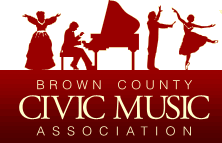Season Listing | Program | Program Notes | Biography
MOZART, Adagio and Fugue in C minor, K.546
It’s a given that every composer profits from the study of Bach. This was true even during the late-18th century, when audiences rejected his dense “learned” style in favor of the lighter galant. Mozart’s own exposure to the Baroque master was indebted to Baron Gottfried van Swieten during his early days in Vienna. As he recounted in a 1782 letter to his sister: the Baron, “whom I visit every Sunday, gave me all the works of Handel and Sebastian Bach to take home with me after I had played them through to him. When Constanze heard the fugues she fell quite in love with them. She will listen to nothing but fugues now . . . Having often heard me play fugues off the top of my head, she asked if I had ever written any down, and when I said I had not, she scolded me very thoroughly for not having written anything in this most artistic and beautiful of musical forms . . . ” The 26-year-old’s lighthearted tone masks a more profound emotion; as Alfred Einstein pointed out more than 50 years ago, Mozart’s study of Bach’s fugues represented “a revolution and a crisis in his creative activity,” internalized through string arrangements of Bach fugues and reflected in major compositions—directly in the Requiem and the “Jupiter” Symphony, more diffusely in the increasingly polyphonic conception of many works from his last decade.
The C minor fugue was first composed in 1783 for two pianos (K. 426) then re-arranged for strings, with an introductory Adagio, in June 1788—the prolific summer during which he also penned his last three symphonies. The adagio alternates a dotted-rhythm reminiscent of a French overture with a more lyrical passage. A French overture normally begins a more extended multi-movement work; in this case, its use serves to establish a period flavor and a sense of occasion. The theme of the fugue is strongly rhythmic, with little of Mozart’s melodic charm—and yet it has the uniquely Mozartean quality of suggesting a character through gesture and nuance. The “crisis in creative activity” was not for naught.
– Susan Key
SUK, Serenade for Strings
If this Serenade for Strings brings to mind echoes of another work by the same name, it isn’t totally coincidence. One of Suk’s most famous teachers was Antonín Dvořák, who was not just a source of musical instruction and inspiration for the teenage composer, but the man who would eventually become his father-in-law.
Bedřich Smetana and Dvořák were two composers responsible for grafting in, and emphasizing, Czech folk idioms or programmatic elements into their compositions, and featuring them in concerts of largely German programming. As the Austro-Hungarian Empire strained under the pressure of ethnic groups grasping for more independence, this was not simply an aesthetic choice, but also a political statement via cultural assertion. Their students would follow suit, though it has been observed that Suk’s compositions eventually utilized fewer Czech idioms, perhaps in an effort to stop comparisons between his music and that of Dvořák.
Dvořák, Three Slavonic Dances
The Slavonic Dances are a series of 16 orchestral pieces composed by Antonín Dvořák in 1878 and 1886 and published in two sets as Opus 46 and Opus 72, originally for piano four hands. Lively and nationalistic, the pieces were well received at the time and today are among the composer’s most memorable works, occasionally making appearances in popular culture.
Prior to the publication of the first set of Slavonic Dances, Dvořák was a relatively unknown composer of modest means. Consequently, he applied for the Austrian State Prize fellowship in order to fund his composing work. After he won the prize three times in four years, Johannes Brahms, one of the members of the award committee, referred Dvořák to his own publisher, Fritz Simrock. The first of Dvořák’s music to be published by Simrock was the Moravian Duets, which attained widespread success; encouraged, Simrock asked the composer to write something with a dance-like character.
Unsure how to begin, Dvořák used Brahms’s Hungarian Dances as a model—but only as a model; there are a number of important differences between the two works. For example, whereas Brahms made use of actual Hungarian folk melodies, Dvořák only made use of the characteristic rhythms of Slavic folk music: the melodies are entirely his own. Simrock was immediately impressed by the music Dvořák produced, and asked the composer for an orchestral version as well. Both versions were published within the year, and quickly established Dvořák’s international reputation. The enormous success of the Opus 46 dances led Simrock to request another set of Slavonic Dances in 1886; Dvořák’s subsequent Opus 72 dances met with a similar reception.
The three dances on this program are, respectively, a furiant, a starodávný (ancient dance), and a furiant.
MOZART, Symphony No. 29
Mozart wrote Symphony No. 29 when he was just 18 years old, following his return to Salzburg after years performing and studying music in Italy with his father. Evidently sufficient funds were available to provide the young prodigy a paid musical position, granting him important opportunities in the development of his career. Symphony No. 29 could be said to represent the beginning of a period of explosive development—although it followed 28 others, the 29th exhibits new musical growth that, in they eyes of many scholars, resulted from Mozart’s exposure to the great works of Joseph Haydn, Gregorio Allegri and others during his Italian travels. After composing the first 27 symphonies in a 9-year period leading up to his 18th birthday, Mozart paused in his symphonic writing for a four-year hiatus following the completion of the Symphony No. 29, as if in acknowledgement of the significance of the piece (during this time, Mozart turned his attention to the concerto, producing five for violin and four for piano).
Symphony No. 29 marks a new phase not only in Mozart’s compositional style, but also in the development of the classical symphony. Staying true to the character of well-established forms (the piece consists of three sonata-form movements and a third-movement minuet), Symphony No. 29 is an early move towards the increased scope of symphonic form, with thematic material that reappears throughout the movements, deepening the unity of the overall work. In keeping with traditional technique, Mozart demonstrates a careful attention to harmony and cadence, but the piece also showcases the beginnings of Mozart’s clever manipulation of such conventions, for example the innovative use of chromaticism, heightened sensitivity to the presence and force of the dominant, starkly contrasting melodic motifs, extrapolation of motivic segments into larger harmonic units. This ingenuity would come to define Mozart’s contributions to the symphonic genre. Symphony No. 29 requires an ensemble of similar scale to prior symphonic works, much smaller than the vast ensembles that would be demanded by the composer’s later symphonies. (Adapted from a note by Mia Tsui)




